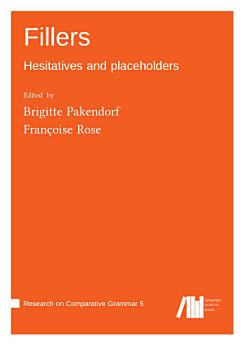Fillers: Hesitatives and placeholders
Tungkol sa ebook na ito
This collective volume comprises in-depth descriptions of conventionalized fillers in a substantial variety of languages from Eurasia, Papunesia, Australia, and the Americas, hoping to stimulate typological research on fillers, both hesitatives and placeholders. The book aims to contribute to a better visibility of the topic among general linguists, to make data and analyses accessible that will be useful for further typological studies on the topic, and to provide models for descriptive linguists.
The introductory chapter discusses issues emerging from the previous literature and offers a new typology of fillers. It also highlights the major findings of the eleven remaining chapters. Each of these contains a detailed and typologically informed analysis of fillers in one or several underdescribed languages, based on corpora of natural speech and focusing on lexical fillers rather than on phenomena below the word-level (phonetic lengthening, truncation) or above the word-level (such as idioms and discourse markers like ‘you know’, or rhetorical questions like ‘what’s the word for that?’). The chapters cover a large amount of diversity, both in terms of languages and with respect to the type of filler. They focus on (i) the criteria for identification of the various types of fillers and the terminology used, keeping in mind that the domain is still largely under construction, (ii) a detailed analysis in terms of morphosyntactic distribution and, if possible, (iii) frequency in speech, and (iv) some reflection on the diachronic development of these disfluency markers.
Tungkol sa may-akda
Brigitte Pakendorf is a Research Fellow of the National Scientific Research Center (CNRS) of France in Lyon (research unit “Dynamique Du Langage”, CNRS/Université Lyon 2). Her research focuses on the languages of Siberia, both from a descriptive perspective as well as with respect to the historical processes that have shaped current diversity. She has undertaken field research to collect narrative corpora of the endangered Tungusic languages Even and Negidal as well as of the Turkic language Sakha (a.k.a. Yakut).
Françoise Rose is a Research Fellow of the National Scientific Research Center (CNRS) of France in Lyon (research unit“Dynamique Du Langage”, CNRS/Université Lyon 2). Her research interests lie primarily in the description of indigenous languages of Amazonia (phonology and morphosyntax). More specifically, she studies Teko (a.k.a. Emerillon, a Tupi-Guarani language of French Guiana) and Mojeño Trinitario (Arawak, Bolivia), on the basis of text data collected in the field. She has written the first comprehensive grammar of Emerillon/Teko. She is also interested in typological, diachronic and areal issues.






